Click on any title to read each book’s reviews below:
- The Santon Sacrifices
- Curious and Unusual Tales
- Isis’ Secret Treasure
- Pearl and Garridan: A Roma Love Story
- The Sylvan Woods of Lake Nemi
- The Blythewood Curse
- Hiding in Paradise
- Sticks and Balls: A Sexologist Pokes Fun at Sports
- The Thelemic Cookbook: Cooking with Correspondences
- From the Mundane to the Magical: A Lifetime of Poetic Moments
- The Collioure Concealment Book 1 of The Inspector Reynard Series
- Murder of the Mystras Nun Book 2 of The Inspector Reynard Series
- The Cypriot Secret Book 3 of The Inspector Reynard Series
- The Rose of Rhodes Book 4 of The Inspector Reynard Series
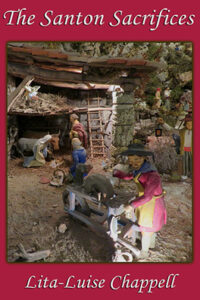 The Santon Sacrifices
The Santon Sacrifices
 “An obsession with revenge that sees no compassion, only blood.”
“An obsession with revenge that sees no compassion, only blood.”
Review by Lilah Shahkhor
“The Santon Sacrifices” is a nasty piece of work, and I mean that in the best of all possible ways. Like a convergence between a gothic horror novel, a historical mystery, and a true crime podcast, this story details the exploits of a serial killer run rampant upon an unsuspecting French village during the Belle Époque of the late 19th century. Occurring in the dead of winter shortly before Christmas as the town of Lambesc is getting ready for its annual holiday celebrations, the first sign that something has gone terribly wrong is when one of the church’s santon figurines is discovered missing. What follows as the townspeople try to discover what happened to the vanished statue is a dark descent into depravity and death.
I was unfamiliar with the custom of santons before reading this book, which does an excellent job at introducing this fascinating folk art tradition. Originating in Provence during the French Revolution, santons are handmade clay figurines which depict the Nativity scene as well tradespeople. So, along with the Baby Jesus and Mother Mary, a typical santon display may also include statues of a fish monger, baker, cheese maker, potter, woodsman, blacksmith, etc. When the villagers notice that the santon representing the local hunter is gone, then shortly after find his corpse laid out in a gruesome display among his own butchering tools, it’s just the first in a string of murders most foul yet to come. Soon enough, the body count starts to rise, with each crime more horrifying than the one before. With the discovery of each new victim, a pattern starts to emerge, revealing a killer that is elaborate and meticulous, as well as truly twisted. We can’t help but notice that these slayings take on an almost ritual quality, they begin to look less random and more like deliberate sacrifices. But to who … and why?
For the answer to that, the author dives deep into the folklore and political past of the era, ultimately revealing a criminal mind driven by a sick and corrupted religious fervor that borders on the satanic, and an obsession with revenge that sees no compassion, only blood.
Consider this a warning; “The Santon Sacrifices” is not for the faint of heart. The book is filled with gore and wickedness. Like a cross between Clive Barker, H.P. Lovecraft, and James Ellroy, it delights in creating awful scenes of unspeakable violence against a backdrop of quaint domesticity and piety, peppered with clever investigative and police work, as those affected attempt to make sense of the unimaginable. If you enjoy procedurals, crime fiction, mean and dirty horror, and learning about strange mythos and superstitions, this book expertly weaves all of those genres together into a story that will keep you up at night, and scare you well into the broad daylight.
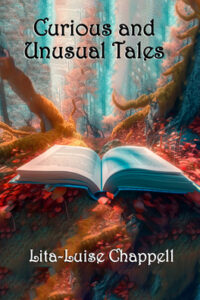 Curious and Unusual Tales Curious and Unusual Tales
Curious and Unusual Tales Curious and Unusual Tales
 “Potpourri of unique, engaging, sometimes unique tales, fables, vignettes, and ruminations”
“Potpourri of unique, engaging, sometimes unique tales, fables, vignettes, and ruminations”
Review by Timothy P. Scott
I greatly enjoyed “Tales” due to their amazing variety and creativity. Ms. Chappell takes you through an entire panorama of genres and styles in her 28 stories, but her unique voice binds them all together. Once you finish the book, you feel that you know something of her inner being and wonder how amazing her life must have been to this point, since many of them are based on real people, places or events.
The pieces are mostly short, averaging about 8 pages, which keeps them engaging and moving crisply from start to end. No unnecessary words! They take the form of unique and intriguing fables, fairy tales, meditations, and vignettes. I’ve read them all twice, and some more than that, and they left me with a lingering sense of wonder and mystery.
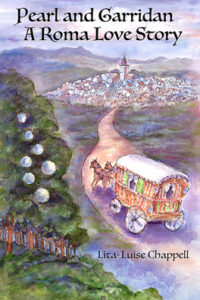 Pearl and Garridan: A Roma Love Story
Pearl and Garridan: A Roma Love Story
 “Two lovely tales filled with magic and lore”
“Two lovely tales filled with magic and lore”
Review by Rafael
I really enjoyed reading Pearl and Garridan and found the story of these two young lovers very absorbing.
It’s very apparent that the author spent a significant amount of time researching Roma customs, and I very much appreciated how carefully these elements were woven into the story. I frequently took brief pauses to look up various references, particularly those concerning food. I highly recommend this book and hope Lita will share more stories with us about this wonderful pair and the magical world they inhabit.
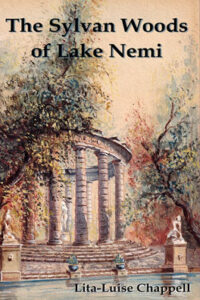 The Sylvan Woods of Lake Nemi
The Sylvan Woods of Lake Nemi
 “Goddess of the hunt and the moon”
“Goddess of the hunt and the moon”
Review by Lilah Shahkhor
Elena Morandi thinks she’s traveling to Italy in order to complete fieldwork for her anthropology doctorate degree, but destiny has more than that in store for her. Her particular area of study is in researching how the ancient cult of the goddess Diana affected the culture and development of the Roman people. She seeks out the expertise and mentorship of Professor Benenati, a cultural historian who specializes in the folk history of the area, and with whose assistance she is also able to secure work with Doctor Nerezza, an archaeologist on a dig at the famous Temple of Diana on the northeastern shore of Lake Nemi.
Her explorations of the dig site lead Elena to discover a secret tunnel under the Nemi cliffs. Whether by exposure to the mind-altering poison that has been set to booby trap the tunnel’s entrance, or by magical forces, or a combination of both, Elena is literally transported into the past and into an underground chamber where ancient priestesses worship at the living Temple of Diana. She is taught the traditional rites of the goddess and is eventually initiated into their sacred circle. Moving back and forth between their world and ours via a sort of mystical veil that only she has access to, Elena finds evidence that artifacts are being stolen from the temple to be sold on the black market. Not only has she stumbled into one of the most profound spiritual experiences of her life, but she’s also now entangled herself in the very dangerous criminal underworld of antiquities smuggling.
What follows is Elena’s fascinating and sometimes harrowing journey in which we along with her learn of the forgotten traditions and folklore of bygone Rome, along with the rituals performed within its sacred sanctuaries – not just as mere observers, but as actual participants. What begins as Elena’s vacation-cum-academic pursuit of a PhD becomes not only a case of solving a crime, but also a transcendent otherworldly adventure through time and space.
Of note: the lovely cover art chosen for this book is of a 1931 painting by the author’s grandfather, titled “the Temple of Diana”. Lamberto Zannazzi grew up in Rome and would visit Lake Nemi with his parents as a child. The book is dedicated to him and also includes one of his original poems, translated from the original Italian. Lita’s brief bio on him reveals an interesting and unexpected artistic connection to early Los Angeles history.
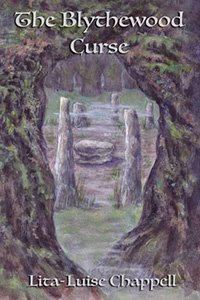 The Blythewood Curse
The Blythewood Curse
 Review by Hattie Quinn
Review by Hattie Quinn
A delightful read. Immersive and evocative. I was transported to the locations, wrapped up in the family drama. The author’s knowledge of the past and her attention to detail shine through. Recommended.
 “Perfect Vacation Getaway Read”
“Perfect Vacation Getaway Read”
Review by Amazon Customer
Set among the historical and fascinating 1890s England’s North York Moors, The Blythewood Curse takes the reader on a magical and mythical journey through old churches, ancient religions, mystical woods and forests, and a small town with big secrets.
The writer describes the area with such attention to detail that one can actually see the escarpments, the flickering lights in the woods, the small quiet town, and the windy pits (which I knew of but never seen). I especially enjoyed the historical and pagan religion aspects that were interwoven in the story.
There is something for everyone in this story- a 10-year-old secret, a father’s mysterious death and the strange epitaph on his grave marker, a handsome headmaster, veiled jealousy, unrequited love, passion, and characters that are memorable and truly interesting.
I found myself eager to read about Amelia and William and their quest to find out why their father moved away and left them an old house with secrets and mysteries of it’s own. I was intrigued by the headmaster of the school, Giles Arden, the school marm and her daughter, who all figure into the story. Who were the former owners of that old house Amelia and William inherited and who is Merton, the curmudgeonly groundsman who seems to know more than what he is revealing?
I took this book with me while I vacationed on the beach and it was a perfect summer read. I couldn’t put it down and read it in 2 1/2 days. That, for me, is a true measure of a gifted storyteller and writer.
Looking for something to read this summer or just a great read in general? I highly recommend The Blythewood Curse by Lita-Louis Chappell.
 “The Blythewood Curse is an enjoyable read.”
“The Blythewood Curse is an enjoyable read.”
Review by Diane Lucero
I applaud the author’s ability to create a believable backdrop for The Blythewood Curse to unfold. The detailed description of homes and surrounding lands of 1890 North York Moors were written in a way that takes you right there with the moist earth under your feet. I appreciated the background of the location, local culture, and religions of the time because it added more texture to this tale. At times I could hear the trees talking or see the flicker of light off in the woods on a dim moonlit night, or feel the rush of air standing over a windypit. I could almost feel the cool air of the back porch on a quiet night. The story unfolds with ease while the reader gains familiarity with the towns and their people. At times the pages flew by as I hurried to find out what happened next to Rowland, his mother Amelia, or her brother William, as well as the father. I was able to read this over a weekend and I feel that is a good sign of an enjoyable book. The story delivers a satisfying ending that wraps up all the important characters as we leave Blythewood. Overall it was enjoyable to read, it did not overwhelm me with too many people or confusing storylines, and it had a good ending. I would recommend this to young readers and adults alike.
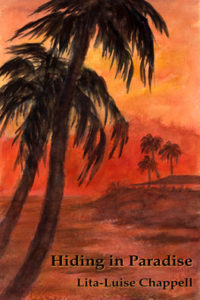 Hiding in Paradise
Hiding in Paradise
 “An escape to get lost in…”
“An escape to get lost in…”
Review by Lilah Shahkhor
Sometimes a book can be the perfect escape. That was both what I wanted and what I got while reading Hiding In Paradise. The story starts off introducing us to Samena Branko and her loving family, who, thanks to her father being the Croatian ambassador to the United States, and them used to that kind of life, she is no stranger to travel, politics, diplomatic functions, and foreign affairs. Her longtime boyfriend Conley Manning, a Croatian undercover agent, originally came into her life when she was in her teens, as it was his job to guard her and her mother when the ambassador was away fulfilling his work obligations.
Samena’s troubles begin when she joins Conley in Barcelona for a much needed romantic getaway. What starts off as a fun game of sorts, with him teaching her some of the tricks of his trade for spying and going undercover, soon turns into a nightmare when he vanishes without a trace. That’s just the start of her difficulties though, because the crime scene she stumbles into next, not only shatters her to the core, but having unknowingly taken a crucial piece of evidence with her, also puts her in great danger. Before she can even decide what to do, she finds herself being hunted down by members of the Croatian Mafia… dangerous thugs who want what she took and who will stop at nothing to get it. But there are also members of an old nationalist organization who are after her, too. The last thing both of these underworld organizations want is for Samena to turn over that evidence to the authorities, or their crimes past and present would be exposed.
This sets Samena off on a whirlwind one-woman race around the world as she tries to outrun and outwit her pursuers. This is when the book picks up its pace and never really lets up on poor Samena, who’s not only dealing with the emotional trauma of what she witnessed, but is also now completely on her own, attempting to stay one step ahead of hardened criminals. Thankfully for her, Samena is whip-smart and not as easy to catch or intimidate as her would-be captors would like. Constantly giving them the slip, and helped by the espionage tricks of disguise and concealment which Conley taught her, she takes the chase from Croatia to Spain, Italy, the U.S., and eventually to an idyllic jungle hideaway in Mexico. The story builds quickly, leaving me at times unable to stop reading because the suspense was too much and I had to know what was going to happen next, as well as Samena leaving her stalkers frustrated to no end! The eventual climax which starts to build from the moment Samena takes off on her escape, did not disappoint, with one pivotal chapter taking place in such a beautiful exotic location, and with such an intense and satisfying outcome, it was a breathtaking scene I won’t soon forget.
A solid adventure tale with a strong female lead, and as much of a love story as it is a tale of independence, Hiding in Paradise was just the book I needed to take me out of my own head for a while, to let go of my worries, and let someone else do the heavy lifting while I tagged along for a most enjoyable ride.
 Sticks and Balls: A Sexologist Pokes Fun at Sports
Sticks and Balls: A Sexologist Pokes Fun at Sports
 “A Home Run!”
“A Home Run!”
Review by Lilah Shahkhor
Sticks and Balls: A Sexologist Pokes Fun at Sports is a rare delight for sports enthusiasts and linguistics lovers alike. Encyclopedic in scope and style, this book is about the duality of words in sports that also have a sexual meaning. Those who are curious about oddities and quirks of the English language will find this study fascinating, whether or not they have any interest in sports. As the author points out in her introduction, the list of terms for just about every sport abounds with sexual innuendo and slang, but especially those games that are played with either a stick or a ball, or both. This is so ingrained in the lingo of sports, and in turn, sports terminology has made it full circle back into our everyday common speech.
Sticks and Balls starts off with a broad look at the development and history of sports, and answers such questions as ‘Why Do Sports Get Us Off?’. Such potentially raunchy topics are handled seriously, but not without humor, as in the section on the ‘Hormones that Sports and Sexuality Share’. Lita-Luise Chappell is a sexologist, now retired, with bachelor and master degrees in psychology and health education, certifications in hypnotherapy, neurolinguistics, erotology, sex education, clinical sexology, and a doctorate in human sexuality. Her background and expertise lend a jocular aplomb to teaching us what amines, peptides, and steroids have to do with making us athletic, as well as horny. Her handling of the prurient content brings a fun approach to what some might consider to be embarrassing subjects; the discussion is straight forward and scholarly, all with the occasional wink and a nod, and all puns intended.
Next, the book delves into the individual sports and their sex-related terms, broken down by sports that use sticks (Archery, Curling, Darts, Fishing, Ice Hockey, Pole Vault, Shuffleboard, Quarterstaff), sports played with balls (Basketball, Bocce, Bowling, Dodgeball, Football, Handball, Kickball, Rugby, Soccer, Volleyball), sports with both sticks & balls (Bandy, Baseball, Billiards, Cricket, Croquet, Golf, Hurling/Camogie, Lacrosse, Polo, Quidditch, Rounders, Shinty), followed by racket & paddle games (Badminton, Table Tennis (aka Ping Pong), Racquetball, Squash, Tennis). Once you make it through this section, you’ll never think of phrases such as ‘home run’, ‘bases loaded’, ‘double header’, ‘switch hitter’, ‘hat trick’ or ‘grand slam’ again without blushing! While not intentionally titillating, make no mistake about it, Sticks and Balls is filled with graphic definitions of words and phrases you’d never use in front of your mother.
The book finishes up with extensive indices of slang words relating to sexual anatomy and activities, along with a bibliography and source lists. This is a bevy of information on the evolution of dirty words, colloquialisms, and semantics.
I am one of those people described at the beginning of this review who have no interest in sports, but this did not detract from my appreciation of what the author has done with this in-depth look at its vernacular. Even more interesting to me than the actual words that connect sex and sports is the overarching idea that we humans have an unconscious need to insert sexuality into everything we do… including ping pong.
 “A Word Nerd’s (wet?) dream come true.”
“A Word Nerd’s (wet?) dream come true.”
Review by John George
This is a very “thick” book, and that’s a good thing. It discusses the overlap between sports & sexuality, from the standpoint of the double entendre of sports terminology. It is very exhaustive, both for the sports covered, and of course the terminology peculiar to each sport.
It also includes an exhaustive list of sexual slang & euphemisms, as an appendix. Lots of fun if you’re into sports, sex, or the fun you can have with the English language. (The book is also very nearly technically perfect for spelling, research &c.) All in all, very highly recommended.
 “Excellent book!”
“Excellent book!”
Review by K.L.
I very much enjoyed reading this book. It is written in an engaging, informative style that is neither too titillating nor too clinical in its content. The author has used her extensive clinical expertise to write a book that can appeal to anyone who is interested in finding the links between sexuality and sports.
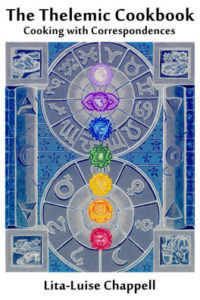 The Thelemic Cookbook: Cooking with Correspondences
The Thelemic Cookbook: Cooking with Correspondences
 “That I may fortify my body thereby.”
“That I may fortify my body thereby.”
Review by Lilah Shahkhor
The Thelemic Cookbook: Cooking with Correspondences is remarkable in a number of ways. At face value, it’s a delightfully unique cookbook by an accomplished chef. Filled with a number of proper classics, for example ‘Sunday Beef Roast with Caramelized Onions, Carrots, Beef Gravy and Gooseberry Jelly‘ (for Crowleymas), as well more international fare, such as ‘Moroccan Saffron Chicken‘ (for Hadit) and ‘Ta’amiya ~ Egyptian Falafel Bites’ (for Tahuti), the recipes are from a wide range of cuisines fitting of their elemental and astrological correspondences, making each presented feast simultaneously surprising as well as delicious. The book does not shy away from lesser known ingredients, introducing us to exotic delights such as ‘Fresh Figs with Candied Lotus Seed Crumble’, ‘Egyptian Butter & Lemon Balm Cookies’, and ‘Rosewater & Orange Blossom Semolina Cake‘.
But what makes this non-ordinary cookbook even more exceptional, and important, is the amount of research and experience that went into its creation. Nothing in this book is random. Each and every course, dish and ingredient is specifically chosen and used for its direct magical correspondence. Milk and eggs are no longer just every day staples when you learn that both of their elemental correspondence is water, and that olive oil and orange zest are both of fire. While one does not need to be versed in magick to appreciate the recipes within, practitioners, especially of Thelema, will come to value this tome as much as they do their copies of Aleister Crowley’s 777, especially if they are foodies who like to cook. In fact, the two books perfectly complement one another. Whereas Crowley’s opus references its correspondences with in depth charts and lists, Chappell’s Thelemic Cookbook takes these connections and turns them into something practical, physical, tangible, and edible. While the book offers its recipes via cleverly orchestrated ritual feasts broken up into seasonal menus, namely to the Thelemic pantheon of deities, the possibilities of where an individual can go with this information opens up a whole new level of working with ritual, devotions, feasts, celebrations, spells, food magic, etc. Follow the book and feed an entire hungry oasis or coven with its ‘Feast Menu for the Spring Equinox‘, or, pick and choose as needed for your own purposes, perhaps making the ‘Blueberry Cheesecake With Silver Almonds‘ from the ‘Three Feasts for the Three Days of the Writing of the Book of the Law‘ as an offering to Nuit, or serving up some ‘Tahuti Moon Salad with Mint and Yogurt Dressing’ at the next potluck.
Lita-Luise Chappell’s lifetime of experiences as a chef, world traveler and priestess have coalesced into this great work, which provides in its pages not only a bevy of tempting courses to “eat and to drink”, but also, if one looks deeper at the possibilities, a simple formula by which one can fortify themselves thereby, and infuse their cooking with both love under will and intention.
 “Delicious recipes with meticulous magical correspondences”
“Delicious recipes with meticulous magical correspondences”
Review by Michael Paul Barry
I received this book as a birthday gift last year, and I couldn’t be more pleased. The recipes are delicious and well themed according to their correspondences , and it creatively uses ingredients that you might not be used to in the average kitchen.
 “Masterpiece of Magickal Feasting!”
“Masterpiece of Magickal Feasting!”
Review by K. M.
Wowee… this book is AMAZING!!! I didn’t even know how badly we needed it until it appeared! Thelemic holidays already tend to be a bit under-celebrated so it has been challenging for me to come up with delicious ways to celebrate them. Lita-Luise Chappell has truly created a masterpiece of cooking with magickal correspondences. In this book, she offers suggestions for menus for all of the major Thelemic feasts, including handy tips on where to buy the best ingredients – super helpful for obscure ingredients such as marigold tea or dried wisteria blossoms – as well as some historical background concerning the feasts and why certain foods may be apropos. The recipes range from very simple and classy – like buttered parsnips – to fairly complex (for a kitchen noob like myself) and still classy, like rhubarb cake with brazil nuts and rhubarb sauce! No idea what the heck Thelema is or why you would ever want to cook with its feasts in mind? Never fear – just skip to page 257, and you will still have 393 interesting pages full of recipes and feast menus relating to the seven classical celestial spheres, the twelve astrological signs and the seven classical chakras! This book deserves a spot on every magician’s kitchen shelf! (Just make sure it’s a strong shelf – this is a big book!!!) The scholarship, love and experience that went into this book is incredible. Worth every cent.
 “This book is basically having a magical Julia Child caterer in your kitchen.”
“This book is basically having a magical Julia Child caterer in your kitchen.”
Review by William
This book has five sections for different recipes, a bibliography, a glossary of cooking terms, retailer’s list and a recipes index. The format is that there are Feasts for different events (Spring and Summer Equinox, Planets, Astrological signs, Chakras, etc). Under each feast, there is a careful crafted menu created by the author, the menu is divided into 7 different parts: Appetizers, Soup/Bread, Salad, Main Course, Side Dishes, Desserts and Beverage Suggestions. Under each part, there are one or more recipes which can be used. Inside the recipes, we have an ingredients list, step-by-step instructions on how to prepare the dish and at the end a correspondence from the author. While reading each recipe, I can feel that the author is beside me and having a conversation with me about the ingredients being used in the dish. Not only that, but the author speaks to you through each recipe.
For example, in her Red Salmon Caviar Bites with Cream Cheese recipe she writes: “I know what you’re thinking, oysters on the half shell and caviar — they don’t really go well with a student’s budget. However, only a small amount per person is needed so a lot goes a long way. After all, it’s a celebration, so make it special.”
The recipes are lovely, the feasts are huge and the guidance of author is genuine and special. This is not your normal Food Network Recipe book, this is take foodie mode to the next level beyond your imagination. I strongly recommend it to anyone. The recipes are made for large quantities (because the recipes as I have mentioned before are for feasts of 10 – 20 people), but you can always do the math and reduce the recipe down.
 “This is an amazing cookbook”
“This is an amazing cookbook”
Review by Stephanie Olmstead-Dean
Okay, first off, the recipes are all delicious and easy to follow. Second, ever wanted to create a meal with a magical theme but didn’t have the time or energy to do the research? Don’t despair — it’s all been done for you, right here! This book would be a bargain at twice the price, but it’s reasonably priced instead. Spiral bound for easy use while cooking, and with a great index of places to find some of the harder-to-source ingredients. A must for any kitchen witch!
 “A Triumph!”
“A Triumph!”
Review by Taren Robinson
Whether you are new to cooking or an old hand, this wonderful cookbook is sure to take you on an adventure you never would have imagined. I have been studying Thelemic Magick for 11 years now and have been an avid student of cooking and culinary technique for the last 20 years of my life. So needless to say I was very excited to hear that this book was being written. Lita Chappell’s greatest triumph with this book is its heart. Whether your are in awe of the fantastical dishes like Chicken Pate en Croute with Escargot en Croute or the Black-Eyed Pea Fritters with Mint Sauce that make you feel like a contestant on Master Chef or whether you are delighted by the elegant simplicity of the Leo Fruit salad or the nostalgic charm of the Prophet and His Bride Anniversary Cake, it is the balance of the refined and gourmet sensibility of a 5-star restaurant with the charisma and exuberance of a theme party that make this cookbook a masterpiece. Just as the Law is for all, so too are the delicious dishes presented in this cookbook. Lita Chappell maintains the most important aspect of this kind of a cookbook, love. All her menus speak directly from their source, that of feeding and nourishing her friends and family. The recipes in this book present many exciting challenges and may well push the pallet of those who mightn’t have been adventurous up to now, but all who pick up this amazing cookbook will be compelled to rise to the challenge just by reading the menu, for Lita makes it all sound so wonderful just from off the page. Her directions are clear and concise, the layout is brilliant for those who might be trying to read through the steam rising from pots on the stove, and the resources given in the Retailer’s List are wonderful and a true God-send. Not to mention the extremely helpful tips and advise peppered throughout the book and some of the trickier recipes. The Piece de Resistance and crowning jewel of the work is the remarkable system of correspondence Lita has developed and lists for all of the foods contained in each recipe. Lita-Luise Chappell has truly set herself among giants in the world of magical scholarship for this work alone. The attention to detail and pioneering work to stand on the shoulders of those who have come before and to reach a realm all her own. Lita has given the world an amazing addition to our practices as Magicians and because of it “as much as meat and drink are transmuted in us daily into spiritual substance” the Miracle of the Mass will never taste the same! The one disappointing note is that correspondences are only given for those items used in the book. Lita-Luise has decided to keep the full list of correspondences from publication, however, one cannot blame her; a Lady, and just as well, a Chef cannot be expected to reveal all her secrets. If you love food and you love Magick this book will synthesize those passions to bring forth an ecstasy that can only be answered by the beauty of love and fellowship as Brothers and Sisters feast and rejoice together. Here’s hoping there will be a volume 2!
 “Wonderful Tasty Magick!”
“Wonderful Tasty Magick!”
Review by Matilda Somerfeld
I really am impressed by the way each dish is amazingly described and preparation is brilliantly broken down. Her correspondences are right on and provide much mystical joy.
 Review by Anon
Review by Anon
This book is nothing short of fantastic! The correspondences are all meticulously researched, the recipes are amazing…it’s a must have for any Thelemite involved in feast planning!
 Review by Sekhet-Maat OTO Lodge
Review by Sekhet-Maat OTO Lodge
This book is incredible & full of literal Magick! Since we obtained our copy it has been used in some capacity to contribute to almost every Feast our lodge has had! Lita-Luise Chappell has collected almost all the information one could ever need to help create feasts so powerful as to alter the consciousness of those eating them without the use of any drugs!
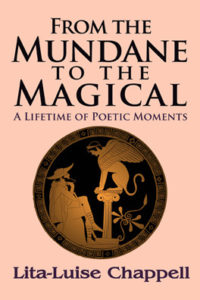 From the Mundane to the Magical:
From the Mundane to the Magical:
A Lifetime of Poetic Moments
From Meg Elison, author of The Book of the Unnamed Midwife
An autobiography is seldom told strait-out. It can be pieced together out of a diary, a lifetime of letters, or the selected remembrances that the write will tell. Lita-Luise Chappell has chosen to collect a life’s work in poetry that tells the tale of her life the way a fan-dancer does; in teasing glimpses and an elegant obfuscation.
 “Bask in the rich poetry of this remarkable woman”
“Bask in the rich poetry of this remarkable woman”
Review by Cynthia
This poet creates a beautiful journey of love, life and self realization which is a joy to experience. Read aloud the words drip from your lips like refined honey and show you strength and beauty within the heart. I enjoyed exploring the highs and lows of this poet’s life through her concrete imagery and would recommend this wonderful book to anyone who appreciates the capriciousness of life. Each poem is offered with an unabashed window into the life of a truly remarkable woman. Grab a glass of your favorite wine, settle near the fireplace and bask in the richness of the poems of Lita-Luise Chappell, I know you will enjoy it as much as I have.
 “Beautiful, thought provoking, inspiring and magickal”
“Beautiful, thought provoking, inspiring and magickal”
Review by Vajrayogini
An exquisite collection of poems that will stimulate your emotions, and resonate on many levels. Ms. Chappell takes you to wondrous, exotic places, She caresses you with love and lust, she elicits utter joy and chuckles, she provokes thought, and she inspires you with magick. A highly recommended collection of poems that you will return to again and again, You will have many favorites…
 Review by Sabrina
Review by Sabrina
Ms. Chappell is an amazing writer capable of bringing the reader along with her in wonderment. Not only is her writing very diverse subject wise, but she also tackles many styles of writing – especially more classic forms, with ease. She speaks on travel, politics, magick, love, and other subjects with a lyrical paintbrush, keeping the reader engaged and wanting more. I was lucky to have gotten to hear the writer read some of these works, because the emotion she conveys when reading these is absolutely beautiful.
 Review by Neil
Review by Neil
From the Mundane to the Magical, by Lita-Luise Chappell, is a collection of poems that radiate sincerity, optimism, love, and magic. The poems in this collection express the power and insight gleamed from someone who truly knows who they are, which inspires the reader to do the same. One of the central themes of these poems is the insight and wisdom gained through varied and diverse experiences. The prepositions “from” and “to” in the title are fitting, for these poems represent the journeys the author herself has undertaken. Whether those journeys be geographical, cultural, sensual, ecstatic, or magical, Chappell brings back insights from her life experiences and unifies them in poetic image-spaces that make them accessible to the experiential core of humanity within all of us.
Chapter I, Poetry about Travel, reveals a myriad of perspectives and reflections garnered from extensive travel. As the author says, in her own words, “Extensive travel not only made me appreciate all the differences that varying cultures offer, it also allowed me to appreciate how similar we all are with the same range of challenges and emotions…I became more tolerant and less judgmental toward others. In fact, the more I traveled the smaller the world became and my sense of family increased” (p. 1). In reading through these poems one gains the impression that each place traveled to reflects an expansion, or new vista and route, through the author’s poetic point-of-view. Whether the setting of the poem be Paris or Mexico, Croatia or Alaska, the author brings the aesthetic dimension of these locations into her own unique vision, synthesizing the diverse elements into a common bond of humanity, allowing the reader to appreciate the various facets of geography, and the modes of life they present. These poems are characterized by tolerance, respect, sensuality, diversity, freedom and a deep appreciation of what other cultures have to offer. The poems in this section that stood out me were: Getting Away, Life is a Road, Santa Maria Maggiore, Kioni of the Ionian Sea.
The poems in Chapter Two, Political Commentary, expresses genuine and heartfelt lament and rage at injustice suffered and a deep empathy for those who have experienced such injustice. As the author notes, in these poems, “There is a teenager’s protest, a woman’s lament, one on historical suppression, and another one sexual abuse” (p. 37). While the themes are general, they are at the same time universal, creating the impression of a kind of solidarity of expression, the author’s voice sometimes reaching to the voice of collective humanity. The poems in this section that stood out me were The Battle, A Woman’s Lament, and The Fault of Faith
Chapters Three and Four, Love Found and Love Lost represent two poles on a spectrum, the heights, ecstasies, and redemptive qualities of love, and on the other hand, the anxieties, fears, and losses that often accompany it. In Love Found one gets the impression that love and sensual pleasure serve as a beacon of light capable of guiding one through stormy weather. Not only is sensuality here spiritualized–raised, so to speak, to its highest pitch–but also seen as capable of being found and appreciated in a variety of forms and aspects. As Chappell notes, “The more I loved, the more I realized that the heart has a great capacity for loving many at the same time” (p. 49). Just as the author finds insight and understanding in diverse geographical location, so too does she find it in the diversity of the expressions of love. This chapter was, for me, inspiring. Poems that stood out to me were: Life of Love, Oh Endless Moon, Spell of the Morning, The Treasures of Our Lives, and The Edge. The poems in love Lost swing to the opposite end of the spectrum; yet, the reader is encouraged to find joy wherever love has left its mark. Chappell writes, “with the heartache that comes from each ending relationship, we eventually learn that love was not truly lost, for love was found and felt (p. 77). Highlights for me in this section were: Love Must Never Stop, Lovers, What Dost Thou Sayeth, and We Three.
In Chapter Five, Magical Works, the theme of travel and diverse experience once again emerges. Magical and mystical journeys now take central stage. As opposed to physical, external travel, these poems seem to represent the journey inwards and what we find in ourselves in these more ethereal and magical moment of our lives. The poems are filled with healing, joy, wonder, and respect. On top of this, several of the poems, such as The Silver Almond Full Moon Spell and Prayer for Good Luck can be used directly, and practically, as spells, in one’s own personal practice. Other poems are also well suited for invocatory purposes. Poems that stood out to me were: The Glories of Our Nature, A Puja for Babalon, The Old Magician, Ode to the Shroom, Thy Life is Thy Garden, and Leda and Her Swan.
Chapter Six, Special Moments, harkens to those moments in our lives that fructify and fortify us on our particular paths. The poems appear to represent those high water marks of our lives, expressing a gratitude for what has transpired, either good or bad, as necessary steps toward a full understanding and embrace of our own Nature. Poems in this section that stood out to me were: It’s a Good Day, The Searcher, Look to Yourself, The Blessings of a Sailor, The Edge of Death, and If I Should Pass Over.
In Chapter Seven, Poems of Great Length, Chappell departs from the short poem and brings the reader deeper into her narrative structures. The first poem, Come Unto Me Said The Boundless Queen of Space, is an excellent presentation of the perspective of the Goddess Nuit, the Goddess of “Infinite Space, and the Infinite Stars thereof”. This poem should be of particular interest to anyone working with the Gods/Goddesses of the Thelemic pantheon, or, with the Goddess in general. The next poem, The Late Chace Meeting, is both entertaining and moving, and highlights what I take to be one of Chappell’s greatest virtues in these poems: Optimism and courage in the face of adversity and tragedy. I hope to see similar narrative style poems from Chappell in the future. The final poem, The Town with the Feathery Crest, is a tale that imparts the ideals of ingenuity and bravery.
I would recommend this collection of poems to anyone pursuing a mystical or magical path, for the poems radiate the sincerity, balance, and passion of one who has walked that path for most of their life. Chappell’s poems communicate the ideals of experience, tolerance, love, optimism, and care, and are a great gift to anyone seeking their own truth. In particular, Chappell’s poetic expressions give insight into the outlook on life born out of a deep seated spiritual orientation to the world and proves a source of guidance for all who walk such a path.
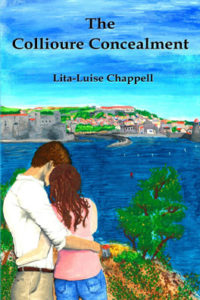 The Collioure Concealment
The Collioure Concealment
Book 1 of The Inspector Reynard Series
 Amazon reviewer from the United Kingdom
Amazon reviewer from the United Kingdom
“Great travel book for the beautiful Collioure”
Loved the setting and adventure. Perfect for a visit to the region with its historical context. Holiday romance, with a twist.
 Review by lightbearer, fallen
Review by lightbearer, fallen
A mystery unravels… For a first time author this is one hell of a ride! Riveting, romantic and revealing…like Eco and Perez Riverte, the author reveals a knowledge of local history and legend…so much that one begins to wonder if there may be soil under those nails… looking forward to the next chapter.
 Review by Cyn Wilkes
Review by Cyn Wilkes
I love the south of France locale as this suspenseful mystery unfolds I found myself turning the pages faster and faster to discover a satisfying ending. It is clear the author did significant research of the area including lush detail to bring the reader into beautiful Southern France.
 Review by Aletheia
Review by Aletheia
The Collioure Concealment is a delight to read. The vivid imagery, development of character, and skillful use of suspense made the story feel fresh and alive throughout. The plot unfolds around a Templar secret buried under the town of Collioure in Southern France, and the gradual reveal keeps the pages turning. Several distinct themes are skillfully woven together in the book. The romantic relationship between the protagonists, Lucien and Chante, is driven by the suspense of the unearthing of the secret, and the intrigue of the contending parties in search of this secret. The story is grounded in the geography of the region, in the history of Southern France, and of the Knights Templar. This combination of fact and fiction, of romance and mystery, creates a gripping narrative that is a pleasure to read from start to finish. Highly recommended!
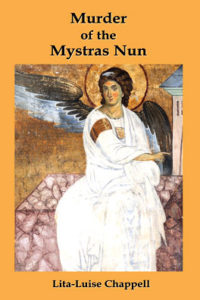 Murder of the Mystras Nun
Murder of the Mystras Nun
Book 2 of The Inspector Reynard Series
 “What was the secret the Mystras nun held that cost her her life?”
“What was the secret the Mystras nun held that cost her her life?”
Review by Timothy P. Scott
Mix in a little “Da Vinci Code”, a little “Holy Blood, Holy Grail” (considered as fiction), a little “Name of the Rose” (murder in a monastery!), add impressively researched historical background, and top off with a twist that I guarantee you never saw coming and you’ll get an idea of “The Murder of the Mystras Nun”. The story jumps deftly between the 18th Century, today, and even to 1st Century Roman-occupied Judea. The characters from all time periods and their interactions are vivid and believable. Historical mysteries aren’t a genre I’m very familiar with, but this was a wonderful story and kept my interest. I appreciate how the tension and excitement gradually ramps up as the story progresses and the threads all start to weave together, matching the excitement of the characters as more and more clues are found. At the end, they reach a conclusion that is tantalizing, provocative and shocking. What was the secret the Mystras nun held that cost her her life? And could it turn out to be history’s greatest lie?
 Review by Skott Holck
Review by Skott Holck
Set in Greek town of Mystras, this mystery does many things before the final pages are turned. It introduced me to Mystras itself, a town I had never heard of, and presented its place in history. It also taught me about the history of the region, and the motivations of its denizens. I learned about the cloistered life of the nuns of the monastery. I learned about how theological concepts could be captured in religious iconography. But I didn’t just learn; this books wasn’t a historic text. I was also entertained by the mystery itself. I enjoyed how the mystery was spread out over multiple timelines and I liked how the author wove it all together. The secrets implied in the story could potentially rock the foundations of the Christianity.
The story was presented in such a way, that I felt immediate immersion into the narrative, from the descriptions of the town and the artwork, to the rich exploration of Greek cuisine, I felt that I was walking the hills of Mystras.
I don’t want to say much of the mystery, because I don’t want to spoil it. I will say that I thought it was going one way, and it shifted and kept me guessing. I don’t read a lot of mystery novels, but I will read more of Lita-Luise Chappell.
 “Gripping Historical Fiction!”
“Gripping Historical Fiction!”
Review by Harper Feist
In this book, Lita-Louise Chappell’s intrepid team Reynard: Lucien, Chante and Gervais, find themselves headed for the Greek island of Mystras. At the outset, Chante and Gervais have been given the mission to help identify a Byzantine princess whose body had just been discovered by archaeologists. Lucien, by profession a police investigator, is only along because he can’t bear to be parted from his newly married wife, Chante, so near the date of their anniversary. In a museum associated with the dig, Lucien discovers the diary of a Venetian policeman. He is consumed by the story in the diary – a tale of murder within an abbey, a murder with clear ties to the church. By the end of this riveting book, the reader comes to realize that the Byzantine princess and the murdered nun in diary, Agatha, have some important things in common – important to the history, and perhaps the continuity, of the Church itself.
It is a story within a story within a story. The most external layer is the search for the identity of the princess. Perhaps because it’s academic, it’s a little less compelling than the story told by Lucien of the murder of the nun, which drives the story and actually makes it a little difficult to put the book down at times. However, the diary and search for the princess’ identity lead irrevocably to a discovery about primary resources from around the time of Jesus’ birth that are at the same time shocking and intuitively obvious.
I am not really a fiction aficionado, but I thoroughly enjoyed this book. I especially enjoyed the novelty of learning about the main characters through their responses to historical documents and religious artifacts. I felt a strong resonance with them because of the way they were so immersed and passionate about the history they were studying. They were, at every point in the book, creating bridges between the past and the present (and in one very wonderful and exceptional moment, the future). I would say that this aspect was my favorite thing about “Mystras”.
If you’re interested in potential alternative explanations for events described in the Bible, this is a great read. If you love reading about people who love and live history, this is a real page-turner.
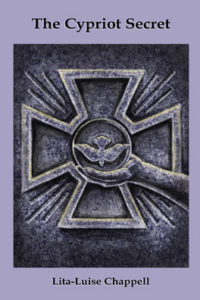 The Cypriot Secret
The Cypriot Secret
Book 3 of The Inspector Reynard Series
 “The Reynard Family’s Adventure Continues in THE CYPRIOT SECRET”
“The Reynard Family’s Adventure Continues in THE CYPRIOT SECRET”
Review by Michael Werckle
The third installment of the Reynard series finds our heroes traveling from France to Greece, Italy, and Malta as they seek further insight into the secret that was revealed to them in the THE MYSTRAS NUN.
Once again, Dr. Chappell creates word paintings of her locations that feel make the reader as if they are experiencing these locales along with her characters. I, for one, felt an immediate desire to see (and taste!) Cyprus for myself!
By this third volume, the Reynard family seem like old friends with whom we are graciously allowed to travel. The kinship that the author elicits between her readers and her characters is one of the great joys of reading these novels. When they are in danger, you fear for them; when they are savoring the fruits of life, you revel with them; when they are pondering life’s mysteries and contradictions, you think for yourself.
One of the reasons that I have enjoyed these books is that they have encouraged me a) to reconsider long-standing beliefs, b) to examine why I hold those beliefs to be true, and c) to consider what would happen to me (and the world) if those beliefs were overturned by alternative narratives. Not everything we are told by those considered to be “authorities” is “truth,” no matter how venerable or illustrious the sources. These novels adeptly show that discernment and discovery of “truth” is both an individual process and one of humanity’s greatest gifts, if we, like Dr. Chappell’s characters, choose to exercise it.
If you are a lover of ancient mysteries, exploring foreign locales, intellectual discovery, and good, old-fashioned tales of romance and intrigue, give these books a read. You may even discover something about yourself along the way.
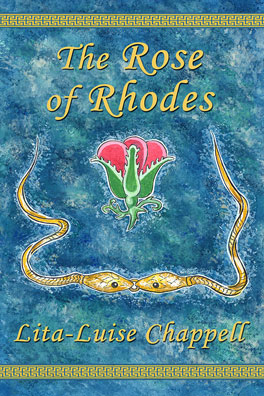 The Rose of Rhodes
The Rose of Rhodes
Book 4 of The Inspector Reynard Series
 “A Grecian mystery with equal parts antiquities and moussaka!”
“A Grecian mystery with equal parts antiquities and moussaka!”
Review by Lilah Shahkhor
The Rose of Rhodes is Book Four in The Inspector Reynard Series by Lita-Luise Chappell. Like the previous three in the series, while it does progress from the book before it, this works just as well as a stand-alone. Even though it had been a couple of years since I’d read the earlier novels, The Rose of Rhodes fully portrayed the characters who populate the series so that I wasn’t lost trying to figure out or remember who’s who. With that said, having read all the series so far, it was a pleasure to get reacquainted with Lucien Reynard and his family again. Here we find him in this latest installment, along with his wife Chante, his father Professor Gervais, and their young daughter Melodia, now 6 years old, in a post-pandemic world just starting to recover from the shutdowns brought about by Covid-19. Happy and eager to return to work, they’ve just accepted their first new assignment from UNESCO, investigating the theft of antiquities from an archaeological dig on the Greek island of Rhodes.
What follows is both an entertaining and twisty detective story as well as a vivid immersion in Greek culture and history as it takes place in and around the Old City of Rhodes. Lita’s books are always dense with highly researched facts and history, a lot of which comes from her own travels and studies in the parts of the world being described, adding an extra layer of authenticity to the plot as it unfolds. One level of the storyline introduces us to the inner workings of an archaeological dig at the Rhodes acropolis, from where several unlikely artifacts, pieces of broken jewelry, had been stolen shortly after they were unearthed. Why would anyone steal these specific items, what was their value, who would have committed and funded such an intricate crime, and what, or who, was the rose of Rhodes? By working in tandem with the local police department as well as following their own leads, interviewing members of the archaeological team, and researching for clues online as well as at the island’s various ancient sites and museums, these were just some of the questions that Inspector Reynard and his team set out to answer.
Along with working to solve the crime, the family also explores and learns about the island with their tour guide, Chloe, a local history teacher who shares her expertise of the area with them via walking tours of the city and driving tours to other parts of the island. She takes them to the Turkish baths built in 1558 known as Great Hammam, the Hospital of Saint John of Jerusalem built by the Knights Hospitaller, the Temples of Athena and Aphrodite at Symi Square, the eleven gates along the Byzantine walls, the Valley of the Butterflies, the ruins of the ancient city of Kamiros, medieval castles, the Lindos acropolis, and many other attractions known to tourists as well as to lesser known yet equally fascinating places.
Things take a turn for the dangerous when the investigation starts to get too close to the truth, with a lead suspect getting murdered just before they could be interviewed, and with young Melodia being approached by a stranger who places a threatening note in her pocket for her parents to find. The closer they get to uncovering the culprit, the less the Reynard’s know who they can trust.
With a flair for storytelling that evokes the culture of wherever her stories take place, Lita-Luise Chappell brings the people and experiences of Rhodes to life, writing prose that awakens the senses to the sights, smells and tastes of the island. Here on Rhodes, we get its culinary delights described in delicious detail when the Reynard’s visit local restaurants to try traditional moussaka, marinated octopus, flaky spinach pies, and baked pasta with soutzoukakia sausages made from spiced pork, or when they get to enjoy Revani cake, made with semolina flour soaked in lemon honey and sprinkled with coconut; a recipe handed down to their B&B’s host by her grandmother. Having read this book while I was in my own lockdown phase of the pandemic, I enjoyed the indulgence of feeling like I was travelling to a faraway place when I wasn’t able to go anywhere. While all I could do was dream of exploring exotic lands, this book was just the ticket I needed to take me there.
Whether returning for the latest escapades of Inspector Reynard and his clan or coming to this book as an introduction to the series, there’s something here for old and new fans alike. Kaliméra… your adventure awaits!
 The official website of Lita-Luise Chappell, writer on sex, magic, food, distant lands, and everyday life with articles, poetry, novels, travelogues, rituals, cookbooks, and short-stories.
The official website of Lita-Luise Chappell, writer on sex, magic, food, distant lands, and everyday life with articles, poetry, novels, travelogues, rituals, cookbooks, and short-stories.
